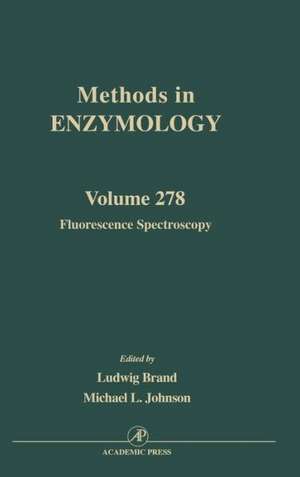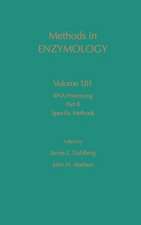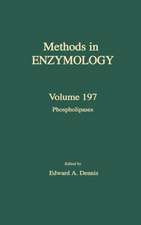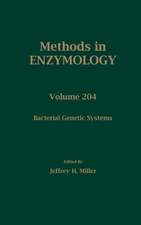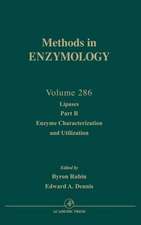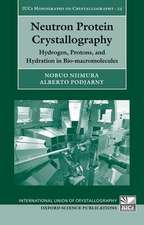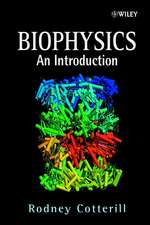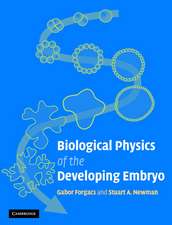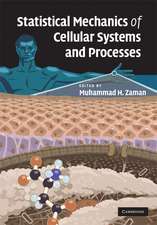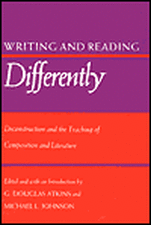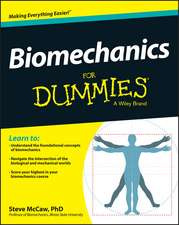Fluorescence Spectroscopy: Methods in Enzymology, cartea 278
John N. Abelson, Melvin I. Simon Ludwig Brand, Michael L. Johnsonen Limba Engleză Hardback – 12 iun 1997
- Fluorescence in biophysics
- Fluorescence as a tool for studying proteins
- Determination of ground-state dissociation constant by fluorescence spectroscopy
- Fluorescence spectroscopy of protein-protein and protein-nucleic acid interactions
- Fluorescence methods for studying equilibrium macromolecule-liquid interactions
- Methods for detecting molecular clusters on cell surfaces
Din seria Methods in Enzymology
- 28%
 Preț: 801.23 lei
Preț: 801.23 lei - 32%
 Preț: 802.54 lei
Preț: 802.54 lei - 23%
 Preț: 461.36 lei
Preț: 461.36 lei - 23%
 Preț: 460.60 lei
Preț: 460.60 lei - 23%
 Preț: 439.86 lei
Preț: 439.86 lei - 23%
 Preț: 448.15 lei
Preț: 448.15 lei - 23%
 Preț: 451.42 lei
Preț: 451.42 lei - 23%
 Preț: 445.18 lei
Preț: 445.18 lei - 5%
 Preț: 557.15 lei
Preț: 557.15 lei - 23%
 Preț: 450.67 lei
Preț: 450.67 lei - 23%
 Preț: 446.23 lei
Preț: 446.23 lei - 23%
 Preț: 435.87 lei
Preț: 435.87 lei - 23%
 Preț: 445.94 lei
Preț: 445.94 lei - 23%
 Preț: 459.55 lei
Preț: 459.55 lei - 23%
 Preț: 460.02 lei
Preț: 460.02 lei - 23%
 Preț: 456.61 lei
Preț: 456.61 lei - 23%
 Preț: 450.54 lei
Preț: 450.54 lei - 23%
 Preț: 453.47 lei
Preț: 453.47 lei - 5%
 Preț: 565.37 lei
Preț: 565.37 lei - 23%
 Preț: 450.67 lei
Preț: 450.67 lei - 23%
 Preț: 464.33 lei
Preț: 464.33 lei - 23%
 Preț: 441.49 lei
Preț: 441.49 lei - 23%
 Preț: 447.44 lei
Preț: 447.44 lei - 23%
 Preț: 459.13 lei
Preț: 459.13 lei - 23%
 Preț: 450.38 lei
Preț: 450.38 lei - 23%
 Preț: 445.80 lei
Preț: 445.80 lei - 23%
 Preț: 445.35 lei
Preț: 445.35 lei - 23%
 Preț: 442.53 lei
Preț: 442.53 lei - 23%
 Preț: 450.38 lei
Preț: 450.38 lei - 23%
 Preț: 448.60 lei
Preț: 448.60 lei - 23%
 Preț: 447.57 lei
Preț: 447.57 lei - 23%
 Preț: 458.97 lei
Preț: 458.97 lei - 23%
 Preț: 440.90 lei
Preț: 440.90 lei - 23%
 Preț: 448.15 lei
Preț: 448.15 lei - 23%
 Preț: 466.84 lei
Preț: 466.84 lei - 23%
 Preț: 451.42 lei
Preț: 451.42 lei - 23%
 Preț: 453.64 lei
Preț: 453.64 lei - 23%
 Preț: 459.13 lei
Preț: 459.13 lei - 23%
 Preț: 457.49 lei
Preț: 457.49 lei - 23%
 Preț: 447.44 lei
Preț: 447.44 lei - 5%
 Preț: 561.34 lei
Preț: 561.34 lei - 23%
 Preț: 447.57 lei
Preț: 447.57 lei - 23%
 Preț: 453.35 lei
Preț: 453.35 lei - 23%
 Preț: 441.95 lei
Preț: 441.95 lei - 23%
 Preț: 450.38 lei
Preț: 450.38 lei - 23%
 Preț: 449.19 lei
Preț: 449.19 lei - 23%
 Preț: 456.02 lei
Preț: 456.02 lei - 23%
 Preț: 455.11 lei
Preț: 455.11 lei - 23%
 Preț: 455.87 lei
Preț: 455.87 lei
Preț: 1167.31 lei
Preț vechi: 1599.06 lei
-27% Nou
Puncte Express: 1751
Preț estimativ în valută:
223.37€ • 233.69$ • 185.55£
223.37€ • 233.69$ • 185.55£
Carte tipărită la comandă
Livrare economică 03-17 aprilie
Preluare comenzi: 021 569.72.76
Specificații
ISBN-13: 9780121821791
ISBN-10: 012182179X
Pagini: 628
Dimensiuni: 152 x 229 x 35 mm
Greutate: 1.04 kg
Editura: ELSEVIER SCIENCE
Seria Methods in Enzymology
ISBN-10: 012182179X
Pagini: 628
Dimensiuni: 152 x 229 x 35 mm
Greutate: 1.04 kg
Editura: ELSEVIER SCIENCE
Seria Methods in Enzymology
Public țintă
Biochemists, biophysicists, cell biologists, and molecular biologists.Cuprins
G. Weber, Fluorescence in Biophysics: Accomplishments and Deficiencies. B.Z. Packard, D.D. Toptygin, A. Komoriya, and L. Brand, Design of Profluorescent Protease Substrates Guided by Exciton Theory. J.M. Beechem, Picosecond Fluorescence Decay Curves Collected on Millisecond Time Scale: Direct Measurement of Hydrodynamic Radii, Local/Global Mobility, and Intramolecular Distances during Protein Folding Reactions. J.A. Schauerte, D.G. Steel, and A. Gafni, Time-Resolved Room Temperature Tryptophan Phosphorescence in Proteins. J.M. Vanderkooi, P.J. Angiolillo, and M. Laberge, Fluorescence Line Narrowing Spectroscopy: A Tool for Studying Proteins. A. Kowalczyk, N. Boens, and M. Ameloot, Determination of Ground-State Dissociation Constant by Fluorescence Spectroscopy. P.R. Callis, 1La and 1Lb Transitions of Tryptophan: Applications of Theory and Experimental Observations to Fluorescence of Proteins. J.B.A. Ross, A.G. Szabo, and C.W.V. Hogue, Enhancement of Protein Spectra with Tryptophan Analogues: Fluorescence Spectroscopy of Protein–Protein and Protein–Nucleic Acid Interactions. M.D. Barkley and M.L. McLaughlin, Time-Resolved Fluorescence of Constrained Tryptophan Derivatives: Implications for Protein Fluorescence. T.E.S. Dahms and A.G. Szabo, Conformational Heterogeneity in Crystalline Proteins: Time-Resolved Fluorescence Studies. M.R. Eftink, Fluorescence Methods for Studying Equilibrium Macromolecule-Ligand Interactions. M.R. Eftink and M.C.R. Shastry, Fluorescence Methods for Studying Kinetics of Protein Folding Reactions. S.S. Lehrer, Intramolecular Pyrene Excimer Fluorescence: A Probe of Proximity and Protein Conformational Change. E. Terpetschnig, H. Szmacinski, and J.R. Lakowicz, Long Lifetime Metal-Ligand Complexes as Probes in Biophysics and Clinical Chemistry. P. Wu and L. Brand, N-Terminal Modification of Proteins for Fluorescence Measurements. P.S. Eis, Fluorescence Studies of Zinc Finger Peptides and Proteins. S.P. Lee and M.K. Han, Fluorescence Assays for DNA Cleavage. D.M. Jameson and J.F. Eccleston, Fluorescent Nucleotide Analogs: Synthesis and Applications. J.J. Hill and C.A. Royer, Fluorescence Approaches to Study of Protein-Nucleic Acid Complexation. M. Yang and D.P. Millar, Fluorescence Resonance Energy Transfer as Probe of DNA Structure and Function. J. Matko and M. Edidin, Energy Transfer Methods for Detecting Molecular Clusters on Cell Surfaces. A.S. Ladokhin, Distribution Analysis of Depth-Dependent Fluorescence Quenching in Membranes: A Practical Guide. A.S. Ladokhin, W.C. Wimley, K. Hristova, and S.H. White, Mechanism of Leakage of Contents of Membrane Vesicles Determined by Fluorescence Requenching. L. Davenport, Fluorescence Probes for Studying Membrane Heterogeneity. K.B. Lee and Y.C. Lee, Preparation of Bifluorescent-Labeled Glycopeptides for Glycoamidase Assay. K. Matsuoka, S.-I. Nishimura, and Y.C. Lee, Preparation of Fluorescent-Labeled Neoglycolipids for Ceramide Glycanase Assays. R.E. McCarty, Applications of Fluorescence Energy Resonance Transfer to Structure and Mechanism of Chloroplast ATPSynthase. Z. Gryczynski, J. Lubkowski, and E. Bucci, Intrinsic Fluorescence of Hemoglobins and Myoglobins. M.L. Johnson, Multiple-Domain Fluorescence Lifetime Data Analysis. Author Index. Subject Index.
Recenzii
Praise for the Series
"The Methods in Enzymology series represents the gold-standard." --NEUROSCIENCE
"Incomparably useful." --ANALYTICAL BIOCHEMISTRY
"It is a true 'methods' series, including almost every detail from basic theory to sources of equipment and reagents, with timely documentation provided on each page." --BIO/TECHNOLOGY
"The series has been following the growing, changing and creation of new areas of science. It should be on the shelves of all libraries in the world as a whole collection." --CHEMISTRY IN INDUSTRY
"The appearance of another volume in that excellent series, Methods in Enzymology, is always a cause for appreciation for those who wish to successfully carry out a particular technique or prepare an enzyme or metabolic intermediate without the tiresome prospect of searching through unfamiliar literature and perhaps selecting an unproven method which is not easily reproduced." --AMERICAN SOCIETY OF MICROBIOLOGY NEWS
"If we had some way to find the work most often consulted in the laboratory, it could well be the multi-volume series Methods in Enzymology...a great work." --ENZYMOLOGIA
"A series that has established itself as a definitive reference for biochemists." --JOURNAL OF CHROMATOGRAPHY
"The Methods in Enzymology series represents the gold-standard." --NEUROSCIENCE
"Incomparably useful." --ANALYTICAL BIOCHEMISTRY
"It is a true 'methods' series, including almost every detail from basic theory to sources of equipment and reagents, with timely documentation provided on each page." --BIO/TECHNOLOGY
"The series has been following the growing, changing and creation of new areas of science. It should be on the shelves of all libraries in the world as a whole collection." --CHEMISTRY IN INDUSTRY
"The appearance of another volume in that excellent series, Methods in Enzymology, is always a cause for appreciation for those who wish to successfully carry out a particular technique or prepare an enzyme or metabolic intermediate without the tiresome prospect of searching through unfamiliar literature and perhaps selecting an unproven method which is not easily reproduced." --AMERICAN SOCIETY OF MICROBIOLOGY NEWS
"If we had some way to find the work most often consulted in the laboratory, it could well be the multi-volume series Methods in Enzymology...a great work." --ENZYMOLOGIA
"A series that has established itself as a definitive reference for biochemists." --JOURNAL OF CHROMATOGRAPHY
